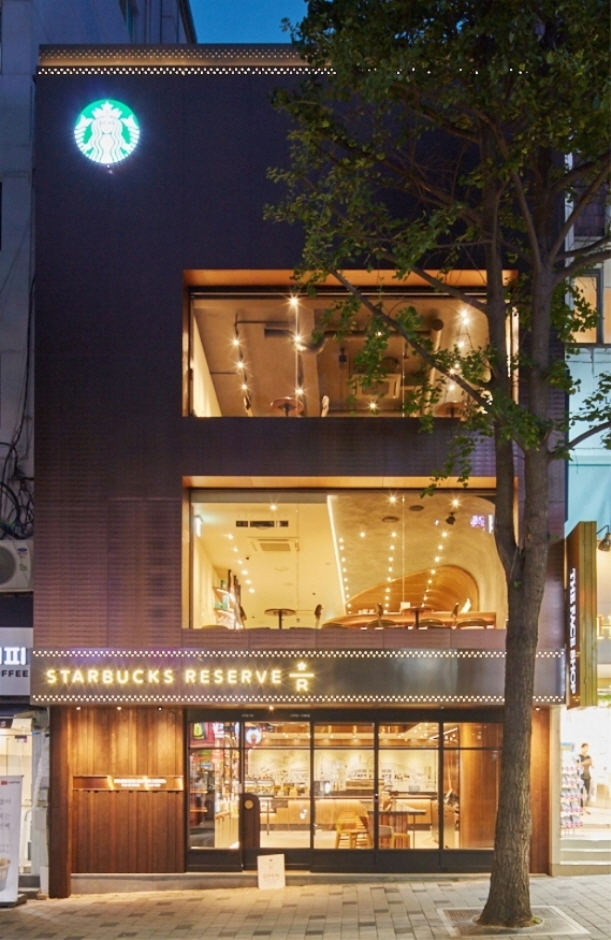Roi Plastic Surgery [Tax Refund Shop] (로이성형외과)
14.2Km 2024-06-27
652, Gangnam-daero, Gangnam-gu, Seoul
-
Nike - Olympic Branch [Tax Refund Shop] (나이키 올림픽)
14.2Km 2024-04-18
1F, 1329, Yangjae-daero, Gangdong-gu, Seoul
-
The Plus Plastic Surgery [Tax Refund Shop] (더플러스 성형외과)
14.2Km 2024-04-19
9, Garosu-gil, Gangnam-gu, Seoul
-
PVH CK Underwear - Garosu Branch [Tax Refund Shop] (PVH CK언더웨어 가로수)
14.2Km 2024-04-18
Store #516-11, 43, Gangnam-daero 154-gil, Gangnam-gu, Seoul
-
Starbucks Edae R (스타벅스 이대R)
14.2Km 2024-12-27
34 Ewhayeodae-gil, Seodaemun-gu, Seoul
Starbucks Edae R store is the first Starbucks store opened in 1999 and Korea's first Reserve only store
Starbucks Edae R store is the first Starbucks store opened in Korea. It is located 150 meters from the front gate of Ewha Womans University. The store has been loved by customers for over two decades since 1999. In celebrating its 20th anniversary in 2019, the store re-opened as Korea's first Reserve-only store. It specializes in offering specialty coffee and memorable experiences to many customers visiting Korea's first Starbucks store. As the leading store presenting the history and future of Starbucks, it offers high-quality coffee in a beautifully decorated setting, along with unique beverages and exclusive merchandise available only at this particular store.
Champion International Company MOK & COO [Tax Refund Shop] (챔피온인터내셔널MOK & COO)
14.2Km 2024-04-22
16, Dosan-daero 11-gil, Gangnam-gu, Seoul
-
Artbox - Garosu Branch [Tax Refund Shop] (아트박스 가로수)
14.2Km 2024-04-16
Store #3, B1 of Block B, 139, Dosan-daero, Gangnam-gu, Seoul
-
Olive Young - Ewha Womans Univ. Jungang Branch [Tax Refund Shop] (올리브영 이대중앙)
14.2Km 2024-04-18
43, Ewhayeodae-gil, Seodaemun-gu, Seoul
-
Olive Young - Misa Gangbyeon Branch [Tax Refund Shop] (올리브영 미사강변점)
14.2Km 2024-06-27
1F, #108, 70, Misagangbyeon-daero, Hanam-si, Gyeonggi-do
-
Homeplus - Jamsil Branch [Tax Refund Shop] (홈플러스 잠실)
14.2Km 2024-04-18
16, Olympic-ro 35ga-gil, Songpa-gu, Seoul
-
![Roi Plastic Surgery [Tax Refund Shop] (로이성형외과)](http://tong.visitkorea.or.kr/cms/resource/31/3313931_image2_1.jpg)
![Nike - Olympic Branch [Tax Refund Shop] (나이키 올림픽)](http://tong.visitkorea.or.kr/cms/resource/96/2878896_image2_1.jpg)
![The Plus Plastic Surgery [Tax Refund Shop] (더플러스 성형외과)](http://tong.visitkorea.or.kr/cms/resource/41/2879741_image2_1.jpg)
![PVH CK Underwear - Garosu Branch [Tax Refund Shop] (PVH CK언더웨어 가로수)](http://tong.visitkorea.or.kr/cms/resource/39/2879739_image2_1.jpg)

![Champion International Company MOK & COO [Tax Refund Shop] (챔피온인터내셔널MOK & COO)](http://tong.visitkorea.or.kr/cms/resource/29/2879729_image2_1.jpg)
![Artbox - Garosu Branch [Tax Refund Shop] (아트박스 가로수)](http://tong.visitkorea.or.kr/cms/resource/48/2879748_image2_1.jpg)

![Homeplus - Jamsil Branch [Tax Refund Shop] (홈플러스 잠실)](http://tong.visitkorea.or.kr/cms/resource/07/2878907_image2_1.jpg)
 English
English
 한국어
한국어 日本語
日本語 中文(简体)
中文(简体) Deutsch
Deutsch Français
Français Español
Español Русский
Русский